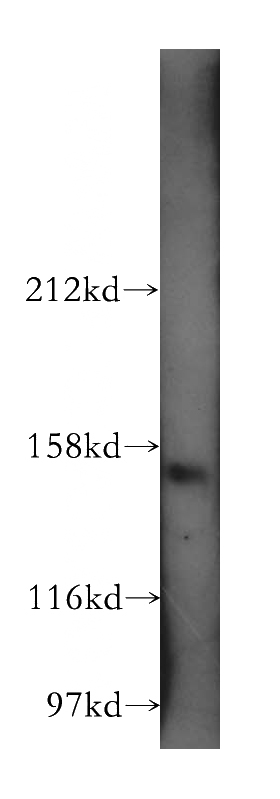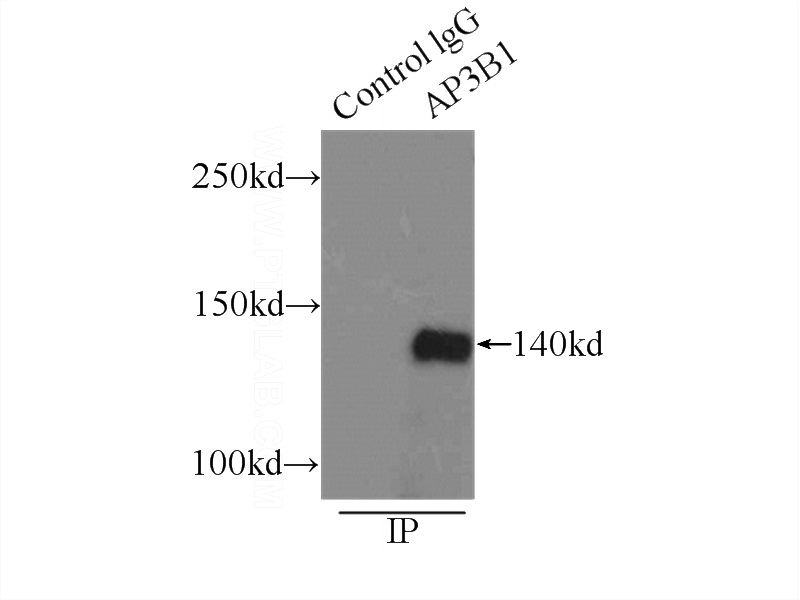-
Product Name
AP3B1 antibody
- Documents
-
Description
AP3B1 Rabbit Polyclonal antibody. Positive IP detected in COLO 320 cells. Positive WB detected in mouse thymus tissue, COLO 320 cells. Observed molecular weight by Western-blot: 140 kDa
-
Tested applications
ELISA, WB, IP
-
Species reactivity
Human,Mouse,Rat; other species not tested.
-
Alternative names
ADTB3 antibody; ADTB3A antibody; AP 3 complex subunit beta 1 antibody; AP3B1 antibody; Beta 3A adaptin antibody; HPS antibody; HPS2 antibody
-
Isotype
Rabbit IgG
-
Preparation
This antibody was obtained by immunization of AP3B1 recombinant protein (Accession Number: NM_003664). Purification method: Antigen affinity purified.
-
Clonality
Polyclonal
-
Formulation
PBS with 0.02% sodium azide and 50% glycerol pH 7.3.
-
Storage instructions
Store at -20℃. DO NOT ALIQUOT
-
Applications
Recommended Dilution:
WB: 1:500-1:5000
IP: 1:200-1:2000
-
Validations

mouse thymus tissue were subjected to SDS PAGE followed by western blot with Catalog No:108121(AP3B1 antibody) at dilution of 1:500

IP Result of anti-AP3B1 (IP:Catalog No:108121, 3ug; Detection:Catalog No:108121 1:500) with COLO 320 cells lysate 2500ug.
-
Background
AP3B1 is the 140-kDa β3A subunit of the adaptor-related protein complex-3 (AP-3), a ubiquitous heterotetrameric complex that is localized to the trans-Golgi network and endosomes and is involved in protein trafficking to lysosomes or specialized endosomal-lysosomal organelles (PMID: 9182526; 9545220). This complex is composed of two lager subunits (δ and β3A or β3B), a medium subunit (μ3A or μ3B), and a small subunit (σ3A or σ3B). The absence of the β3A subunit (AP3B1) results in the loss of stability of AP3 and leads to degradation of μ3A, to which β3A is directly bound, while the other subunits are variably affected (PMID: 16507770). AP3B1 contains three main domains: the N-terminal head domain, the hinge, and the C-terminal ear domain. It has been reported as a target of IP(7)-mediated pyrophosphorylation (PMID: 19934039). Defects in AP3B1 are the cause of Hermansky-Pudlak syndrome type 2 (HPS2) (PMID: 10024875; 16507770).
-
References
- Bultema JJ, Ambrosio AL, Burek CL, Di Pietro SM. BLOC-2, AP-3, and AP-1 proteins function in concert with Rab38 and Rab32 proteins to mediate protein trafficking to lysosome-related organelles. The Journal of biological chemistry. 287(23):19550-63. 2012.
- Sun W, McCrory TS, Khaw WY, Petzing S, Myers T, Schmitt AP. Matrix proteins of Nipah and Hendra viruses interact with beta subunits of AP-3 complexes. Journal of virology. 88(22):13099-110. 2014.
- Zlatic SA, Grossniklaus EJ, Ryder PV. Chemical-genetic disruption of clathrin function spares adaptor complex 3-dependent endosome vesicle biogenesis. Molecular biology of the cell. 24(15):2378-88. 2013.
- Ryder PV, Vistein R, Gokhale A, Seaman MN, Puthenveedu MA, Faundez V. The WASH complex, an endosomal Arp2/3 activator, interacts with the Hermansky-Pudlak syndrome complex BLOC-1 and its cargo phosphatidylinositol-4-kinase type IIα. Molecular biology of the cell. 24(14):2269-84. 2013.
- Zlatic SA, Tornieri K, L'Hernault SW, Faundez V. Clathrin-dependent mechanisms modulate the subcellular distribution of class C Vps/HOPS tether subunits in polarized and nonpolarized cells. Molecular biology of the cell. 22(10):1699-715. 2011.
- Gokhale A, Larimore J, Werner E. Quantitative proteomic and genetic analyses of the schizophrenia susceptibility factor dysbindin identify novel roles of the biogenesis of lysosome-related organelles complex 1. The Journal of neuroscience : the official journal of the Society for Neuroscience. 32(11):3697-711. 2012.
Related Products / Services
Please note: All products are "FOR RESEARCH USE ONLY AND ARE NOT INTENDED FOR DIAGNOSTIC OR THERAPEUTIC USE"
